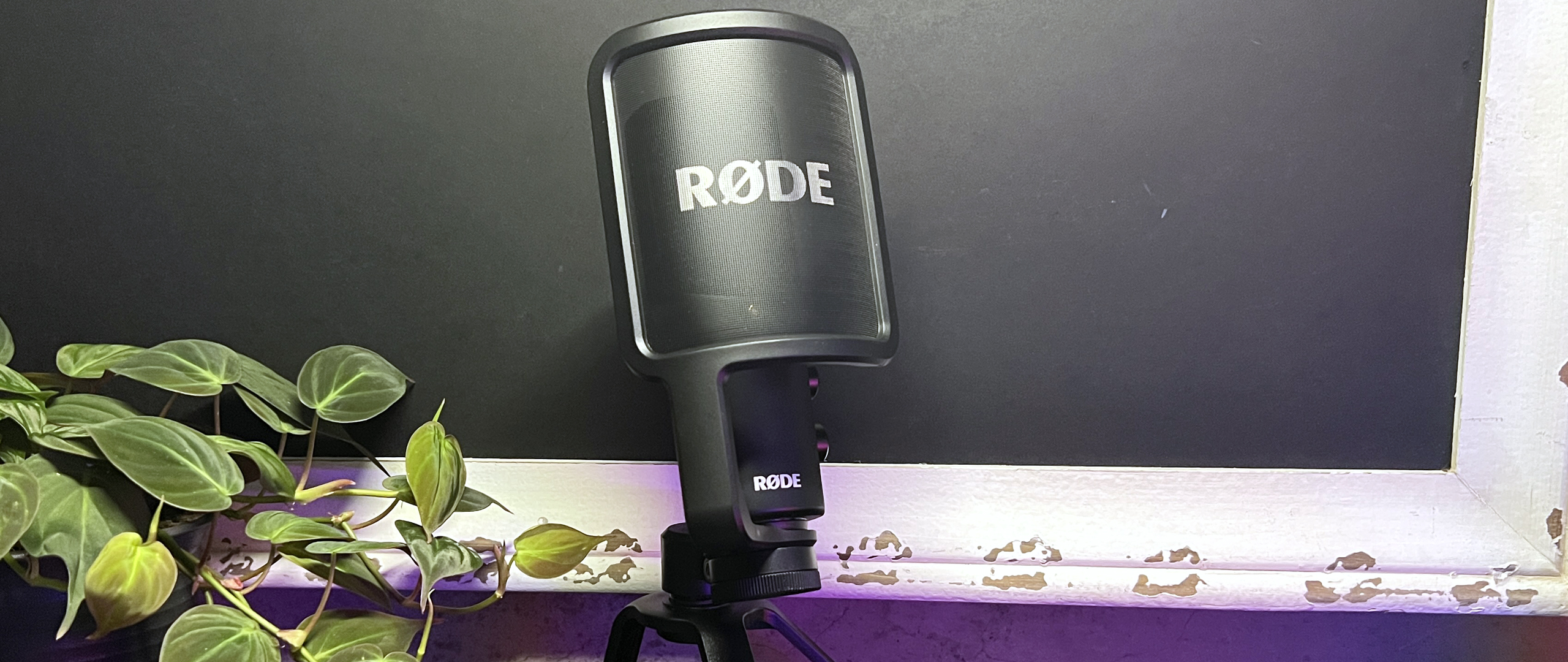Tom's Hardware Verdict
The NT-USB+ is a great internal update to the NT-USB, but it might be nice to also see an external update.
Pros
- +
Sturdy, well-built
- +
Comes with detachable pop filter
- +
Sounds fantastic
Cons
- -
No on-mic gain control
- -
Louder audio sources still clip
Why you can trust Tom's Hardware
Rode’s NT-USB microphone is a solid, great-sounding condenser microphone — but it was first released in 2014 and is definitely overdue for an update (it uses a USB-B cable). Enter: the Rode NT-USB+.
The NT-USB+ retains the NT-USB’s sturdy, professional design on the outside and adds some pretty impressive updates — such as enhanced circuitry, Rode’s Revolution Preamp technology, and an internal DSP — on the inside. (Oh, and it also has a USB-C port.) The Rode NT-USB+ comes with a detachable pop shield and a tripod desktop stand, and features a headphone jack for direct, zero-latency monitoring. It’s one of the better-sounding USB microphones we’ve heard, and is a solid contender for our list of best gaming mics.
The NT-USB+ is available now for $169.
Design of the NT-USB+
The NT-USB+ is almost identical in design to the original NT-USB. The NT-USB+ is housed in a solid, black metal body with Rode’s logo printed neatly across the front in light silver. Under the mic’s black metal mesh grille is a blue mesh internal pop filter — the blue is the biggest aesthetic difference between the NT-USB+ and the NT-USB.


On the right side of the mic, there’s a 3.5mm high-power headphone output for zero-latency monitoring, as well as two dials to control mix (between the mic’s direct output and your PC’s playback) and headphone volume level.




The NT-USB+ comes with a 9.8-foot (3m) USB-C to USB-C cable, which attaches to the USB-C port on the bottom of the mic. It also comes with a detachable pop shield — a rounded metal screen with a plastic frame that sits about one inch in front of the mic — as well as a black tripod stand.


The stand is plastic — relatively sturdy but pretty lightweight, and it definitely has the potential to tip over if you’re not careful. It does an adequate job of holding the mic up, once balanced, however. With no heft or padding, it also doesn’t do much to dampen desktop noise, though it’s not much worse than most desktop stands. The mic comes with a detachable ring mount that can be easily mounted on a boom arm (or a different stand).
Get Tom's Hardware's best news and in-depth reviews, straight to your inbox.
Specs
Capsule Type | Condenser |
Frequency Response | 20 - 20,000 Hz |
Polar Pattern | Cardioid |
Orientation | Side Address |
Sample Rate | 48 kHz |
Bit Depth | 24-bit |
Adjustable Gain | None |
Connectivity | USB-C |
Cable | USB-C to USB-C (9.8ft/3m) |
Software | Rode Connect |
Dimensions (H x W x D) | 7.2 x 2.4 x 2 inches / 184 x 62 x 50 mm |
Weight | 1.2lbs / 540g (not including accessories) |
MSRP | $169.00 |
Performance of the NT-USB+


The NT-USB+ is a side-address USB microphone with a cardioid polar pattern. It records 24-bit/48 kHz audio — a step up from the NT-USB’s 16-bit bit depth — and has a frequency response of 20 - 20,000 Hz. It’s USB-C powered and features a headphone jack for direct, zero-latency monitoring. The mic works well as a plug-and-play device, though it doesn’t have on-mic gain control or a mute button/switch.
The NT-USB+ produces excellent vocals — rich and detailed, with a solid low end and very little self noise. It features Rode’s ultra-low-noise, high-gain Revolution Preamp technology, which allows it to pick up louder, cleaner, crisper audio with a lower noise floor, and the difference is definitely audible.
One of the issues I’ve found with the NT-USB is that its gain is pretty high and it has trouble recording audio from louder sources, such as instruments, without clipping. While this isn’t as much of an issue for streaming, gaming, or video conferencing, it’s worth noting if you’re looking for a mic that can be used beyond the PC. The NT-USB+ does better with this, but it’s still not amazing — and it would be nice to see an on-mic gain control to help with balancing.
Features and Software of the NT-USB+
The NT-USB+ is largely plug-and-play, but it does feature an internal DSP that allows for advanced audio processing — which can be activated using a number of Rode apps, including Rode Central (the brand’s mic companion app), Rode Connect (the brand’s free podcasting and streaming software), and the newly released Rode X Unify software.
At the moment, the compressor, noise gate, high pass filter, and Aphex enhancements (“aural exciter” and “big bottom”) can be unlocked but cannot be adjusted or otherwise configured like the brand’s new Rode X microphones.
Bottom Line
The Rode NT-USB+ adds Rode’s Revolution Preamp technology, an advanced internal DSP, and USB-C connectivity to what was already an impressive USB condenser microphone — it’s a very good (and somewhat overdue) internal update to the NT-USB.
The NT-USB+ retains its predecessor’s solid, sturdy build, and delivers fantastic-sounding, clean audio with a lower noise floor — if you’re looking for a mic that will make you sound great, look no further. It still struggles a little with louder audio sources, however, and its bit depth/sample rate is studio-quality but not high-res. If you’re looking for a mic for both streaming and recording, a high-res mic such as the Beyerdynamic Fox Studio microphone might be a better choice.

Sarah Jacobsson Purewal is a senior editor at Tom's Hardware covering peripherals, software, and custom builds. You can find more of her work in PCWorld, Macworld, TechHive, CNET, Gizmodo, Tom's Guide, PC Gamer, Men's Health, Men's Fitness, SHAPE, Cosmopolitan, and just about everywhere else.

